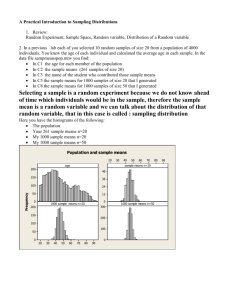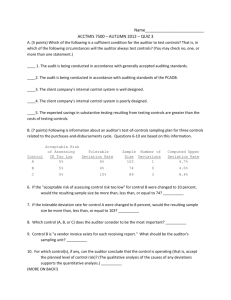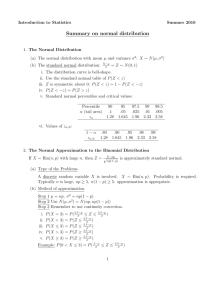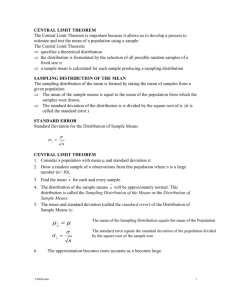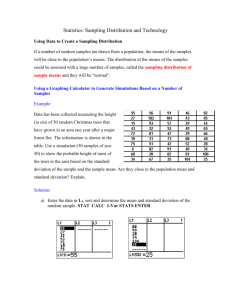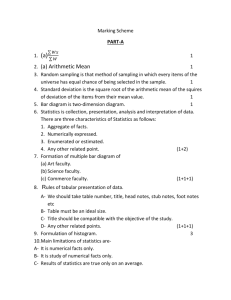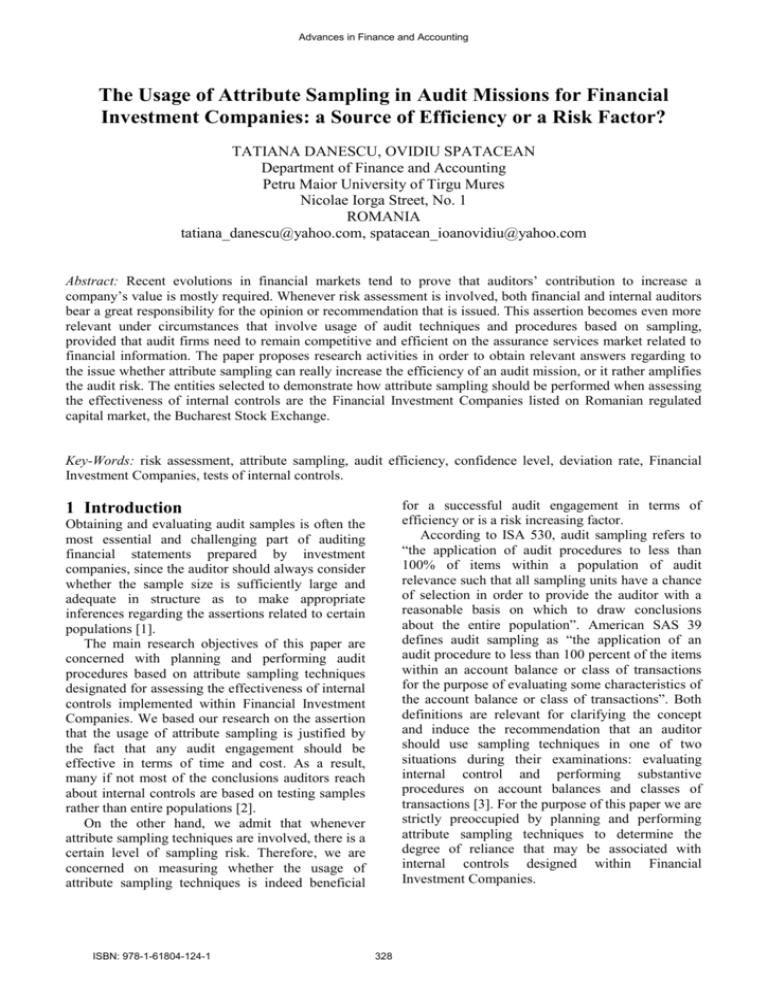
Advances in Finance and Accounting
The Usage of Attribute Sampling in Audit Missions for Financial
Investment Companies: a Source of Efficiency or a Risk Factor?
TATIANA DANESCU, OVIDIU SPATACEAN
Department of Finance and Accounting
Petru Maior University of Tirgu Mures
Nicolae Iorga Street, No. 1
ROMANIA
tatiana_danescu@yahoo.com, spatacean_ioanovidiu@yahoo.com
Abstract: Recent evolutions in financial markets tend to prove that auditors’ contribution to increase a
company’s value is mostly required. Whenever risk assessment is involved, both financial and internal auditors
bear a great responsibility for the opinion or recommendation that is issued. This assertion becomes even more
relevant under circumstances that involve usage of audit techniques and procedures based on sampling,
provided that audit firms need to remain competitive and efficient on the assurance services market related to
financial information. The paper proposes research activities in order to obtain relevant answers regarding to
the issue whether attribute sampling can really increase the efficiency of an audit mission, or it rather amplifies
the audit risk. The entities selected to demonstrate how attribute sampling should be performed when assessing
the effectiveness of internal controls are the Financial Investment Companies listed on Romanian regulated
capital market, the Bucharest Stock Exchange.
Key-Words: risk assessment, attribute sampling, audit efficiency, confidence level, deviation rate, Financial
Investment Companies, tests of internal controls.
for a successful audit engagement in terms of
efficiency or is a risk increasing factor.
According to ISA 530, audit sampling refers to
“the application of audit procedures to less than
100% of items within a population of audit
relevance such that all sampling units have a chance
of selection in order to provide the auditor with a
reasonable basis on which to draw conclusions
about the entire population”. American SAS 39
defines audit sampling as “the application of an
audit procedure to less than 100 percent of the items
within an account balance or class of transactions
for the purpose of evaluating some characteristics of
the account balance or class of transactions”. Both
definitions are relevant for clarifying the concept
and induce the recommendation that an auditor
should use sampling techniques in one of two
situations during their examinations: evaluating
internal control and performing substantive
procedures on account balances and classes of
transactions [3]. For the purpose of this paper we are
strictly preoccupied by planning and performing
attribute sampling techniques to determine the
degree of reliance that may be associated with
internal controls designed within Financial
Investment Companies.
1 Introduction
Obtaining and evaluating audit samples is often the
most essential and challenging part of auditing
financial statements prepared by investment
companies, since the auditor should always consider
whether the sample size is sufficiently large and
adequate in structure as to make appropriate
inferences regarding the assertions related to certain
populations [1].
The main research objectives of this paper are
concerned with planning and performing audit
procedures based on attribute sampling techniques
designated for assessing the effectiveness of internal
controls implemented within Financial Investment
Companies. We based our research on the assertion
that the usage of attribute sampling is justified by
the fact that any audit engagement should be
effective in terms of time and cost. As a result,
many if not most of the conclusions auditors reach
about internal controls are based on testing samples
rather than entire populations [2].
On the other hand, we admit that whenever
attribute sampling techniques are involved, there is a
certain level of sampling risk. Therefore, we are
concerned on measuring whether the usage of
attribute sampling techniques is indeed beneficial
ISBN: 978-1-61804-124-1
328
Advances in Finance and Accounting
the potentially severe consequences of a Type II
decision error, auditors design their sampling
applications to keep this risk to an acceptable low
level. However, the auditor is able to reduce the
sampling risk by increasing the likelihood of a
sample being representative, by using professional
care in designing the sample selection and
evaluation of sample results.
Audit sampling also involves non-sampling risk
that may arise from the possibility of sampling the
wrong population when testing one particular
internal control feature, the possibility of failing to
detect deviations from the projected internal
controls when performing an audit procedure or the
possibility of misinterpreting a particular audit
result. While statistical sampling allows the auditor
to quantify and control sampling risk, no sampling
method allows the auditor to measure non-sampling
risk, which should be controlled by adequate
training, proper planning and effective supervision
[6].
2 Problem Formulation
Attribute sampling is typically applied in
compliance testing, where the auditor is concerned
to establish whether or not a particular characteristic
is present. In compliance testing, the characteristic
is usually representative of whether a particular
internal control procedure has been properly applied
or performed. Attribute sampling may also be used
for tests of transactions because it measures the
frequency of occurrence [4].
Audit sampling cannot be used to test the
operating effectiveness of all internal controls.
Usually, sampling techniques can be used only
when performance of internal control leaves some
evidence of performance, such as a completed
document or the initials of the person performing
the control procedure. This evidence of performance
allows the auditor to determine whether the internal
control procedure was applied to each item included
in the sample [5].
In sampling for testing internal controls, the
auditor identifies the characteristics of a particular
internal control procedure (attribute) and the
deviations (absence of attribute). An attribute
sampling plan is used most commonly to determine
the operating effectiveness of a control in terms of
deviations from a prescribed internal control
procedure.
Whenever auditors apply to attribute sampling
techniques during the performance of audit
engagements, sampling risk is involved. This
particular risk refers to the possibility that the
selected sample may not be representative of the
population and therefore the auditor is likely to draw
inadequate conclusion regarding the effectiveness of
internal controls, based on the sample.
Furthermore, attribute sampling techniques are
the source of two relevant type of decision error met
during the performance of audit missions: (i) Type I
error dealing with the risk of incorrect rejection,
occurs when one sample supports a conclusion that
the internal controls are not operating effectively,
when, in truth, they are. This is also known as the
risk of assessing control risk too high; (ii) Type II
error dealing with the risk of incorrect acceptance
occurs when one sample supports a conclusion that
the internal controls are operating effectively, even
though, in reality, they do not. This is also known as
the risk of assessing control risk too low. While
Type I error relates to the efficiency of an audit
engagement since the auditor should plan and
perform more audit testing, Type II error relates to
the effectiveness of the audit engagement since the
auditor is likely to fail detecting a material
misstatement in the financial statements. Because of
ISBN: 978-1-61804-124-1
2.1
Planning the Sample
Planning the sample should assure that audit
procedures used to test a certain sample, are
performed in a manner that provides the desired
sampling risk and minimize the likelihood of nonsampling errors. Proper planning of attribute
sampling involves completing major phases,
described as it follows.
2.1.1 Determine the Test Objectives, Attribute
and Failures
Control procedures can be implemented in many
different forms, and the nature of the
implementation affects the auditor’s approach to
gathering evidence on the effectiveness of the
procedures [7].
Usually, the relevant objectives related to
attribute sampling for investment companies, take
into account: (a) testing the designed and operating
effectiveness of internal control; (b) measuring the
reliance degree that can be placed on internal
controls; (c) testing the accuracy of processing
transactions with financial instruments and (d)
determining compliance with laws, regulations and
investment company policies.
2.1.2 Define the Population Characteristics
This planning phase may be divided into some
distinctive sub-phases, such are:
defining the period covered by tests. As a practical
matter, tests of controls are often performed prior to
the balance sheet date and may cover an interim
period of the fiscal year. If the control procedures
329
Advances in Finance and Accounting
are found to be effective, the auditor should take
additional steps to ensure that they continue to be
effective during the remainder of the year.
defining the sampling population, meaning a
certain internal control procedure that is applied for
a certain class of transactions with financial
instruments. The auditor must make sure that the
population used for sampling is appropriate to the
objectives previously defined and reflects a
complete representation of the total population of
interest;
defining the sampling unit in relation to the control
being tested, usually a certain type of document, an
entry or a line item on a document;
defining the control deviation conditions, meaning
departures from or failures of adequate performance
of internal control. For instance, when a sample item
does not have one or more of the attribute, it is
classified as a deviation.
population deviation rate below the tolerable
deviation rate. Instead, the auditor should plan and
perform additional substantive procedures rather
than relying on the internal controls. There is a
direct relationship between the expected population
deviation rate and the sample size, so that the larger
the expected deviation rate is, the larger the sample
size, all else equal.
2.2
2.1.3. Determine the sample size
An optimally determined sample size is considered
to minimize sampling risk and promote audit
efficiency.
This
planning
phase
requires
considerable judgment and is highly correlated to
the computation of the three key-factors:
desired confidence level, which is the complement
of the risk of incorrect acceptance. If the auditor sets
control risk too low and over-relies on the internal
controls, the level of substantive procedures may be
too low to detect material misstatements that may be
present in the financial statement account.
Generally, when the auditor decides to rely on
internal controls, the confidence level is set at 90%
or 95%, meaning he is willing to accept 10% or 5%
risk of incorrect acceptance. Between the
confidence level and the sample size there is a direct
relationship, meaning that the more confident the
auditor would like to be, the larger the sample size
must be, all else equal.
tolerable deviation (failure) rate, meaning the
maximum deviation rate from a prescribed control
that the auditor is willing to accept and still consider
the control effective. The tolerable deviation rate is
inversely related to the sample size, meaning that
the lower the tolerable deviation rate is set, the
larger the sample size must be, all else equal.
expected population deviation (failure) rate, which
is the rate the auditor expects to exist in the
population, due to particular human involvement. If
the auditor appreciates that the expected population
deviation rate exceeds the tolerable deviation rate,
the statistical sampling should not be performed,
because no amount of sampling can reduce the
ISBN: 978-1-61804-124-1
Selecting the Sample
Once the sample size has been determined, the
auditor must decide how to select a representative
sample of the application of internal controls
throughout the period being tasted. ISA 530 requires
that the sample items should be selected in such a
way that the sample can be expected to represent the
population, provided that all items must have an
equal opportunity to be selected. In practice, the
auditors may select audit samples by using several
statistical methods: the random-number selection
method, the systematic (interval) selection, the
stratified sampling, the cluster (multistage) sampling
or the value-weighted selection. For non-statistical
sampling, the auditor may use professional
judgement to select a representative sample.
However, statistical sampling should benefit the
auditor in designing an efficient sample, measuring
the sufficiency of the evidence obtained and
evaluating sample results.
2.3 Performing the Audit Procedures and
Evaluating the Results
After the sample items have been selected, the
auditors conduct audit procedures as they have been
previously planned: inquiry of legal representatives,
observation of employee’s performance of regular
duties, inspection of documents, reports and
electronic files, and re-performance of internal
control procedures by the auditor [8].
Whenever a deviation is observed in testing
internal controls, auditors should evaluate the
qualitative aspects of the deviations identified, by
investigating the nature, the causes and the
consequences of each relevant type of deviation or
exception. Under each relevant circumstance, the
auditor should determine whether a particular
deviation represents an unintentional error
(misunderstanding of instructions, unintentional
misfiling or carelessness) or a fraud and whether the
deviation actually may result in a monetary
misstatement to the financial statements.
After completing the audit procedures, the
auditor summarizes the deviations for each internal
control tested and evaluates the results on a
quantitative basis by comparing evidence regarding
330
Advances in Finance and Accounting
the deviation rate in the sample to the tolerable
deviation rate determined when planning the
sample. When evaluating the results of testing
internal controls, the auditor is normally concerned
only with whether the true deviation rate exceeds
the tolerable deviation rate.
2.4
recorded financial instrument transactions have
indeed occurred, are complete, accurate, properly
classified and recorded in the proper time period.
For the specific research objectives, we
determined as relevant the following internal control
procedures projected and performed within
Financial Investment Companies in relation to
acquisition, holding and disposal of financial
instruments [9]:
- Control 1: All acquisitions and disposal of
financial instruments are approved by the
Investment Committee according to the investment
strategy and policies.
- Control 2: All acquisitions and disposal of
financial instruments are properly classified and
recorded in the correct period.
- Control 3: Financial investments are properly
valued at the balance sheet date and related gains or
losses are calculated with sufficient accuracy.
- Control 4: All rights, dividends or interests are
properly classified, recorded and allocated for the
correct period.
Drawing Sampling Conclusions
When drawing relevant conclusions about the
statistical sampling application for tests of internal
controls, the auditor compares the tolerable
deviation rate to the computed upper deviation rate.
The latter represents the sum between the sample
deviation rate and an appropriate allowance for
sampling risk and sets an upper limit on how high
the population deviation rate might actually be, at a
controlled level of sampling risk.
If the computed upper deviation rate is less than
the tolerable deviation rate, the auditors may
conclude that the tested internal controls can be
relied upon. On the contrary, if the computed upper
deviation rate exceeds the tolerable deviation rate,
the auditors must conclude that internal controls are
not effective, meaning are not operating at an
acceptable level.
3.2
3 Problem Solution
We propose to describe a detailed illustration of
attribute sampling techniques that may be planned
and performed for Financial Investment Companies,
as part of the control risk assessment procedures that
are projected by auditors. The research methodology
consists of: examining the legal framework applied
to these entities (NSC Regulation no. 15/2004),
reviewing the internal manual for control procedures
adopted by the management, inspecting the list of
transactions with financial instruments and the list
of security holdings to define the populations,
inquiring the legal representatives through specific
control risk questionnaires and observing the
common practice used by the external auditors of
these entities. The five Financial Investment
Companies listed on Bucharest Stock Exchange are:
FIC Banat-Crisana (FIC 1), FIC Moldova (FIC 2),
FIC Transilvania (FIC 3), FIC Muntenia (FIC 4) and
FIC Oltenia (FIC 5).
Based on the research work, the relevant
sequences of the attribute sampling program have
been synthesized in the following paragraphs.
3.1 Determine the Test Objectives and
Attributes
For any Financial Investment Company, control
procedures should be in place to ensure that
ISBN: 978-1-61804-124-1
Determine Deviation Conditions
In relation with each internal control procedure
defined, we determined as relevant the following
deviation conditions:
- Control 1: Some acquisitions or disposals of
financial investments are not approved by the
Investment Committee. Each of these deviations
must be investigated to determine the cause of
failure and the potential materiality.
- Control 2: Some acquisitions or disposals of
financial investments are misclassified or allocated
to the wrong period. These failures may bear a
significant impact on the financial performances and
require a special attention for presumptive
fraudulent financial reporting.
- Control 3: Fair value computed for financial
instruments held for trading is not accurate. Usually,
the risk implied whenever these deviations are
detected refers to an over-valuation of financial
position. The auditor must adopt a vigilant attitude
based on professional skepticism in order to detect
any possible fraudulent reporting.
- Control 4: Some rights, dividends and interests
related to financial instruments held in portfolio are
misclassified, omitted or allocated in the wrong time
period. Whenever these deviations are detected the
auditor must investigate the cause with extreme
caution, due to the fact that under such
circumstances, misappropriation of assets may be
favored.
331
Advances in Finance and Accounting
3.3
control procedure that has been previously defined
for financial investments:
Define the Population to be Sampled
The populations subject to attribute sampling refer
to: (i) the total number of transactions that have
been closed during the period 1st January – 31st
December 2011; (ii) the total positions of tradable
share holdings from the detailed list of investments
reported under NSC Regulation no. 15/2004
requirements at 31st of December 2011.
The population size for each of the five
Financial Investment Companies is represented in
Table 1.
Table 2 Sample size for testing internal controls
Parameters
Control Control Control Control
1
2
3
4
Desired
90%
95%
95%
95%
confidence
level
Tolerable
5%
4%
3%
3%
deviation rate
Expected
2%
1.5%
0.5%
0.75%
population
deviation rate
Sample size
132
192
157
208
Source: AICPA, Auditing Practice Release, Audit
Sampling (New York, 2001)
Table 1 Population size for attribute sampling
Population
FIC 1
FIC 2
FIC 3
Parameters/Entity
Investment Transactions
7.754
32.317
34.791
(thousands of Euro)
Holdings of Securities
108
102
107
traded on a regulated
market (Items)
Population
FIC 4
FIC 5
Parameters/Entity
Investment Transactions
11.699 31.629
(thousands of Euro)
Holdings of Securities
94
40
traded on a regulated
market (Items)
Source: FIC 2011 Annual Reports
We conclude that the desired confidence level is
95% for Controls 2-4 (higher than in case of Control
1), due to the implications of possible fraudulent
reporting or misappropriation of assets. As a
consequence, the tolerable deviation rate is lower
for Controls 2-4 than for Control 1, for the purpose
of increasing the sample size. The expected
population deviation rate was projected taken into
account the human interference possibility, anytime
the accounting information system is not fully
protected against human error. Based on these
statistical parameters, we determined that sample
size is bigger for testing internal controls with a
higher desired confidence level and a lower
tolerable deviation rate.
These populations were selected due to their
relevance in subsequent substantive testing. While
the first population allows substantive testing for a
class of transactions (acquisition of financial
instruments), the second allows substantive testing
of account balances (holding of financial
instruments). In practice, the number of transactions
that have been closed is a more relevant indicator
for the first population.
Data presented in Table 1 suggest that three
Financial Investment Companies (FIC 2, FIC 3 and
FIC 5) have a relatively similar value in stock
acquisitions during the reporting period, with an
average of 32.912 thousands of Euro. Considering
the total positions in stock portfolio, we can group
FIC 1, FIC 2 and FIC 3 as being close related with
an average of 106 companies per each stock
portfolio. These observations are of a great
importance when determining other statistical
parameters needed for sample sizing.
3.4
3.5
Table 3 Results for testing internal controls
Sample Item
Control Control Control Control
1
2
3
4
1
√
√
√
√
2
√
E
√
E
…
15
E
√
√
√
…
30
√
E
√
E
31
√
√
√
√
32
√
√
E
E
…
125
E
√
√
√
126
√
E
√
√
…
208
√
√
√
E
Number
Define the Sampling Parameters
Table 2 reflects an example on how to fundament
the decision for determining sample size in relation
with each parameters required on each internal
ISBN: 978-1-61804-124-1
Evaluate the Sample Results
After selecting the samples and testing the items for
each internal control procedure, we determined in
Table 3 the results computed as mean values for the
five Financial Investment Companies.
332
Advances in Finance and Accounting
account balances related to financial investments, in
a cost-effective manner. Nevertheless, using
sampling techniques involves the risk that the
selected samples are not representative for the
populations. In response, statistical theory allows
auditors to measure this risk and manage it by
determining the appropriate sample size.
Under either type of attribute sampling
(statistical or non-statistical), the auditor is primarily
concerned with obtaining sufficient evidence to
support the planned level of control risk specified in
the auditor’s preliminary audit strategy. When
deciding whether to rely upon internal controls,
auditors should maintain a vigilant attitude and a
sense of professional skepticism in order to assure a
proper balance in terms of efficiency and
effectiveness associated to audit missions performed
for Financial Investment Companies.
of deviations
2
3
1
4
Sample
size
132
192
157
208
Sample
deviation rate
1.5%
1.6%
0.6%
1.9%
Desired
confidence level
90%
95%
95%
95%
Upper
deviation rate
4.4%
3.9%
3.2%
4.6%
Tolerable
deviation rate
5%
4%
3%
3%
Auditor’s
decision
SR
SR
NSR
NSR
√ – proper performance of internal control procedure
E – internal control procedure not performed properly
SR – supports reliance
NSR – does not support reliance
Source: Authors’ projection adapted from Messier W., et
al., 2008.
By comparing the upper deviation rate (obtained
from Statistical Sample Results Evaluation Table)
with the tolerable deviation rate (set by the auditor
using professional judgment), we were able to
determine the following results:
(a) The tested internal control 1 and 2 can be relied
upon, since the computed upper deviation rate is
less than the tolerable deviation rate. Under these
circumstances, using attribute sampling proves to
increase both audit efficiency and effectiveness by
diminishing the risk of incorrect acceptance through
statistical methods. Nevertheless, using nonstatistical sampling could alter the results in the
sense of increasing the risk of overreliance.
(b) The tested internal control 3 and 4 cannot be
relied upon, since the computed upper deviation rate
is higher than the tolerable deviation rate. Under
these circumstances, using attribute sampling is not
recommended and the auditor should increase
accordingly the amount of substantive tests. We
consider that, if attribute sampling is used under
such circumstances the audit effectiveness is altered
by increasing the risk of assessing control risk too
low, even if efficiency is maintained. Based on this
assumption, it is very likely that the auditor might
issue an inadequate opinion upon the financial
statements, provided that material misstatements
could not be prevented by substantive testing.
References:
[1] Arens A. A., Elder R. J., Beasley M. S.,
Auditing and Assurance Services. An
Integrated Approach, Pearson Prentice Hall,
2008.
[2] Ricchiute D.N., Auditing, Thomson SouthWestern, 2006.
[3] Louwers T. J., Ramsay R. J., Sinason D. H.,
Strawser J.R., Auditing and Assurance
Services, McGraw-Hill Irwin, 2007.
[4] Soltani B., Auditing. An International
Approach, Financial Times Prentice Hall, 2007.
[5] Whittington O.R., Pany K., Principles of
Auditing & Other Assurance Services,
[6] Messier W.F., Glover S.M., Prawitt D.F.,
Auditing and Assurance Services. A Systematic
Approach, McGraw-Hill Irwin, 2008.
[7] Rittenberg L.E., Schwieger B.J., Auditing.
Concepts for a Changing Environment,
Thomson South-Western, 2005.
[8] Boynton W.C., Johnson R.N., Modern
Auditing. Assurance Services and Integrity of
Financial Reporting, John Wiley & Sons, Inc.,
2006.
[9] Danescu T., Spatacean O., Objectives and Risks
in Auditing Financial Investments, Financial
Audit Journal, No. 12, 2008, pp.21-25.
[10] www.sif1.ro www.sifm.ro www.transif.ro
www.sifmuntenia.ro www.sifolt.ro
4 Conclusion
When auditing the financial statements prepared by
the Financial Investment Companies, the use of
sampling is a very common practice because of the
need to obtain and evaluate evidence over large
populations either of classes of transactions or
ISBN: 978-1-61804-124-1
333



